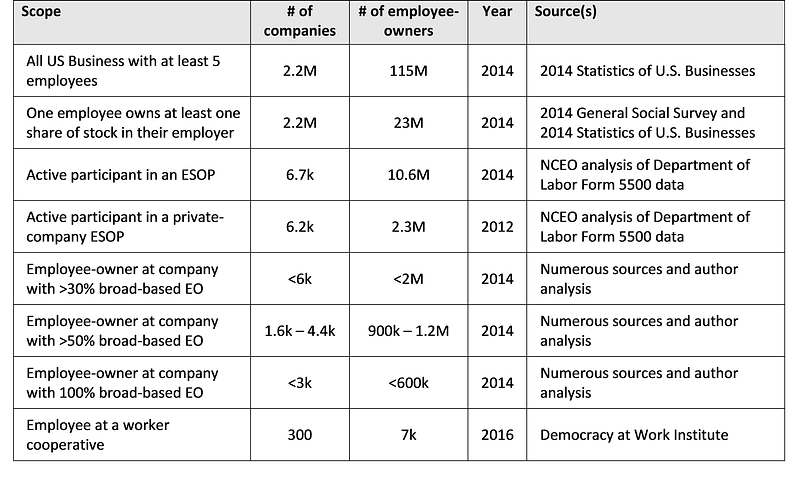by Thomas Dudley
Employee ownership (EO) is gaining traction as a way to address a number of social questions including rising wealth inequality, and the best way to create strong local economies As a sign of employee ownership’s increasing importance look no further than Colorado, where Congressman Jared Polis kicked-off his gubernatorial campaign at Save-A-Lot, an employee-owned grocery store.
If we are to seriously promote employee ownership as a new way forward for the American economy, we should first understand where employee ownership is at today. It turns out the size of employee ownership is intrinsically linked to how you define “employee ownership”. These two questions — “how do you define EO?” and “how large is the employee-owned economy?” — are questions I have spent considerable time on, first as a member of the 50 by 50 design team and now as a co-founder of Certified Employee-Owned. Let’s walk through a few ways of defining EO and what that means for the employee-owned economy.

Before we jump into EO, let’s take a look at the size of the American private sector. Each year, every business operating in our economy is counted by the U.S. Census Bureau. The results are summarized in the Statistics of U.S. Businesses (SUSB). According to the SUSB, in 2014 there were 5.8 million businesses employing 121 million Americans in the private sector. Not all of these businesses would be eligible to be employee-owned — for example companies setup by a lone freelancer. Looking at firms with at least 5 employees, we find 2.2 million businesses employing 115 million Americans.
Now thinking about employee ownership, the most general notion of EO would include everyone who has any ownership stake in their place of work. There are numerous forms of ownership, but stock ownership is the core of American capitalism. After all, it is the stock owners who are entitled to a company’s profits and who elect the board of directors. If we define EO as encompassing everyone who owns at least one share of stock in their employer, we cast a wide net. This definition includes everyone from a low-level employee who owns a few shares in their 401k, to a partner at a law firm, to a CEO who owns 100% of their business.
It’s reasonable to assert that over 99% of businesses in America employ at least one person who owns at least one share of stock. Therefore this definition of EO includes nearly every business in the private sector. While every business has some EO, not every employee is a stock-owner. Luckily the 2014 General Social Survey asks Americans working in private businesses if they own stock in their employer. Of those surveyed, roughly 20% responded in the affirmative. Combining this with the number of people in the private sector means there are 23 million Americans who report owning at least one share of stock in their employer.
A stricter definition of EO would only include companies that have broad-based employee ownership, where broad-based means that access to ownership is open to all employees and concentration of ownership is limited in some way. The most prolific vehicle of broad-based employee ownership in America is the Employee Stock Ownership Plan (ESOP). According to National Center for Employee Ownership (NCEO) analysis of Department of Labor form 550 data, in 2014 there were 6.7 thousand ESOPs with 10.6 million active participants.
Some of the most highly regarded EO companies in America have ESOPs including Publix, King Arthur Flour, Lifetouch, and WinCo Foods. However, the vast majority of participants in ESOPs are at large public companies where the ESOP owns just a small portion of the company — often less than 1%. For example, Walmart is the largest ESOP employer in America, accounting for 1.1 million active ESOP participants alone. Just a few hundred public-company ESOPs account for the majority of ESOP participation. Private-company ESOPs number around 6.2 thousand and have 2.3 million active participants.
We can rule out companies like Walmart by further narrowing our definition to only include companies with significant and broad-based employee ownership by employees. Popular demarcations are at 30% (based on historical precedent, and also the standard we use for Certified Employee-Owned), 50% (based on majority control), and 100% employee ownership. Unfortunately there is no single source of information on percent employee ownership across companies and the best we can do today is provide rough estimates based on information gathered from a variety of sources. The exact numbers are summarized in the table above, but significant and broad-based employee ownership likely includes no more than 7 thousand companies with 2 million employees. Comparing these numbers to the size of the private sector we see that significant and broad-based employee ownership includes just 0.3% of U.S. Businesses and employs just 1.9% of the private sector.
Finally, we can include employee control as a third and final factor in EO. This gets us to the worker cooperative model. Again, there is no consensus on the exact definition, but according to the Democracy at Work Institute, there are 300 worker cooperatives with 7 thousand worker-owners.
While we see a wide range of sizes, any definition of EO that includes great employee-owned companies and excludes businesses like Walmart results in an employee-owned economy that is a small portion of the private sector. The implication is clear. We need bold and ambitious plans to get to 50 million employee owners by 2050. More on how to get there in my next post.
